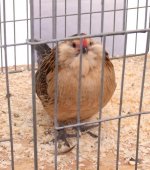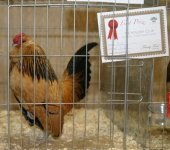elmwood
New member
- Messages
- 416
- Location
- Staffordshire
BARBU D'UCCLE - Bearded & Booted Belgium Bantam
In the Uk we have 3 varieties of standardised Belgium Bantam-
Barbu d'Uccle - bearded & feather legged
Barbu d'Anvers - bearded & clean legged
Barbu De Watermael- crested, bearded & clean legged
All True Bantams - meaning they have no larger counterparts. The Barbu D'Uccle is considered to be derived from crossing the Barbu d'Anvers from Antwerp with the Sablepoot Booted Bantam from Netherlands. (The sablepoot has feathered feet & non-bearded)
The Barbu d'Uccle originates from a small town on the outskirts of Brussels and were first imported in 1911. They are much more popular in Germany and the Netherlands where large numbers in a wide range of colours varieties can be seen at the major shows. There has been a revival of interest in the UK 1990'S onwards.
The Barbu D'Uccle is a cute little hen with a beard and feathery feet. They are a gentle and docile bird with a placid, easy-going nature. With regular handling they become very friendly, trusting and tame birds. They are known as the ballerinas of the bantam kingdom- rarely standing still and dancing on their toes... being light on their feet means they tend to do less damage to the garden making them an all round desirable pet. They are good fliers, and regularly fly up on to my shoulders.
They are good sitters and mothers, can sit on up to approx 9 eggs. They lay a small pale egg, but are not prolific layers.
They have a small single comb, inconspicious earlobes & very small wattles- the smaller the better. They have distinctive but delicate head-gear each side of the face, and below the chin - the neck "boule". They look like they have a collar or muff. The body is short and broad, as is the back leading to the tail which is high, almost upright. Wings are held so that they slope towards the ground and held very closely to the body. They are extremely regal/majestic looking birds.
The Porcelain and Millefleur (thousand flowers), were the main colour varieties found in the early d'Uccles followed by black and white. The Porcelain has a ground colour of straw, each feather being marked with a pale-blue spangle and v-shaped white tip. The Milliefleur has a ground colour of golden mahogany, with a black spangle on each feather and again a white v-shaped tip.
A fancy breeder is required to have a little patience as this bird can take upto 18 mths to develop the "essential type" giving extended show pen time.
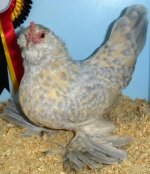
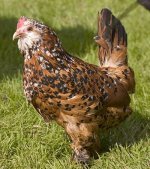
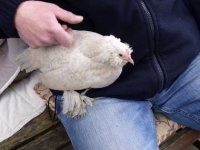
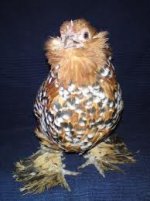
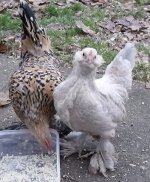
In the Uk we have 3 varieties of standardised Belgium Bantam-
Barbu d'Uccle - bearded & feather legged
Barbu d'Anvers - bearded & clean legged
Barbu De Watermael- crested, bearded & clean legged
All True Bantams - meaning they have no larger counterparts. The Barbu D'Uccle is considered to be derived from crossing the Barbu d'Anvers from Antwerp with the Sablepoot Booted Bantam from Netherlands. (The sablepoot has feathered feet & non-bearded)
The Barbu d'Uccle originates from a small town on the outskirts of Brussels and were first imported in 1911. They are much more popular in Germany and the Netherlands where large numbers in a wide range of colours varieties can be seen at the major shows. There has been a revival of interest in the UK 1990'S onwards.
The Barbu D'Uccle is a cute little hen with a beard and feathery feet. They are a gentle and docile bird with a placid, easy-going nature. With regular handling they become very friendly, trusting and tame birds. They are known as the ballerinas of the bantam kingdom- rarely standing still and dancing on their toes... being light on their feet means they tend to do less damage to the garden making them an all round desirable pet. They are good fliers, and regularly fly up on to my shoulders.
They are good sitters and mothers, can sit on up to approx 9 eggs. They lay a small pale egg, but are not prolific layers.
They have a small single comb, inconspicious earlobes & very small wattles- the smaller the better. They have distinctive but delicate head-gear each side of the face, and below the chin - the neck "boule". They look like they have a collar or muff. The body is short and broad, as is the back leading to the tail which is high, almost upright. Wings are held so that they slope towards the ground and held very closely to the body. They are extremely regal/majestic looking birds.
The Porcelain and Millefleur (thousand flowers), were the main colour varieties found in the early d'Uccles followed by black and white. The Porcelain has a ground colour of straw, each feather being marked with a pale-blue spangle and v-shaped white tip. The Milliefleur has a ground colour of golden mahogany, with a black spangle on each feather and again a white v-shaped tip.
A fancy breeder is required to have a little patience as this bird can take upto 18 mths to develop the "essential type" giving extended show pen time.







